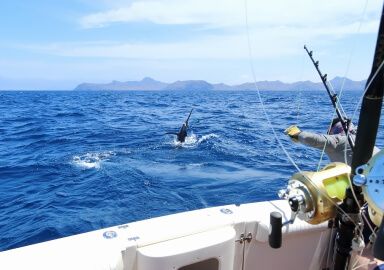Hamour
A legend of the Arabian Gulf, and important in much of the Indo-Pacific region, the hamour is a medium-sized predator of the grouper family.
View 30 listings
30
listings
–
price starting from
3
countries
–
to the nearest trip
Where and When?
More than 11 different fish are called “hamour” but the gold-spotted rockcod is the most common of them. In the Arabian Gulf hamour have been caught, mostly with the help of fish traps, for hundreds of years, and are still an important food source. In the United Arab Emirates and other country of the region the hamour has a status of a legend and is the most important fish for the local anglers.
Overall, the hamour is distributed in the warmer areas of the Indo-Pacific region. It can be caught from the Red Sea south round Africa to South Africa, eastwards past Australia to Fiji and Palau then west and north to Japan. It is a species of brackish and marine areas and can be common in estuaries and lagoons into which the juveniles usually migrate. As they grow, they mostly move to deeper waters and adults are more common offshore in depths down to about 100 m. (328 ft.). They prefer sandy or muddy substrates, where they can more easily hunt for crustaceans such as crabs and shrimps.
About Hamour
The hamour (Epinephalus coioides), also called the gold-spotted or brown-spotted grouper was an important commercial food species historically, although many populations have dwindled markedly. The species has the typical grouper body, elongate and robust with large fins, particularly the pectorals. The mouth is large and armed with an effective array of many small, curved teeth that make it almost impossible for engulfed food to escape. Their eyes are big, and the upper areas of the body are brownish, blending down the flanks to almost white. Along the sides are many brown, red, or orange spots that shrink but multiply with age.
Hamour is called a “diandric protogynous hermaphrodite”, which means that some young fish develop to become males, and stay males, while others initially become functioning females and then change to males. They spawn offshore and relatively few eggs are laid per female, as they are usually smaller than males. The record fish was 120 cm. (47 in.) and weighed 15 kg. (33 lbs.) but most fish caught now are well under 50 cm. (20 in.). The species feeds mostly on bottom-living invertebrates such as shrimps and crabs, but fish become important in the diet as they grow.
How to Catch?
Hamour hunt during the day and throughout the year although, in cooler areas, the catch rates may be lower in winter. Fishing at night is unrewarding and many, possibly most, hamour will bury in the sand and exude a wreath of “slime” around their bodies.
Hamour can be shore-caught in estuaries, but most fishing is from small boats. Light to medium spinning equipment with dead bait or artificial lures is effective. Along much of the African, Indian and SE Asian coast small boats go out daily and, using small whole fish or bits of natural bait, hand line vast numbers of hamour, mostly small ones. Sport anglers usually target larger specimens but, in most areas, numbers of large hamour are low and other species are usually present and often the main target.
Bottom for large hamour is practiced off the Australian coast and warm areas of the South African east coast. The best bait, when using bottom rigs, is small whole fish or fresh chunks of fish, crab, shrimp or squid. Artificial lures, both plastics and hard lures are being used more often and can be successful.
The capture of a really large hamour will usually require a small investigation to find a suitable locality and an experienced charter operator. Local knowledge is essential and, if you can find a local operator known to catch good hamour, he can take you to the best spots and provide the right equipment and recommend the right baits and lures. Catching a trophy hamour is not easy and, even when everything else is in place, a little good luck is essential.





